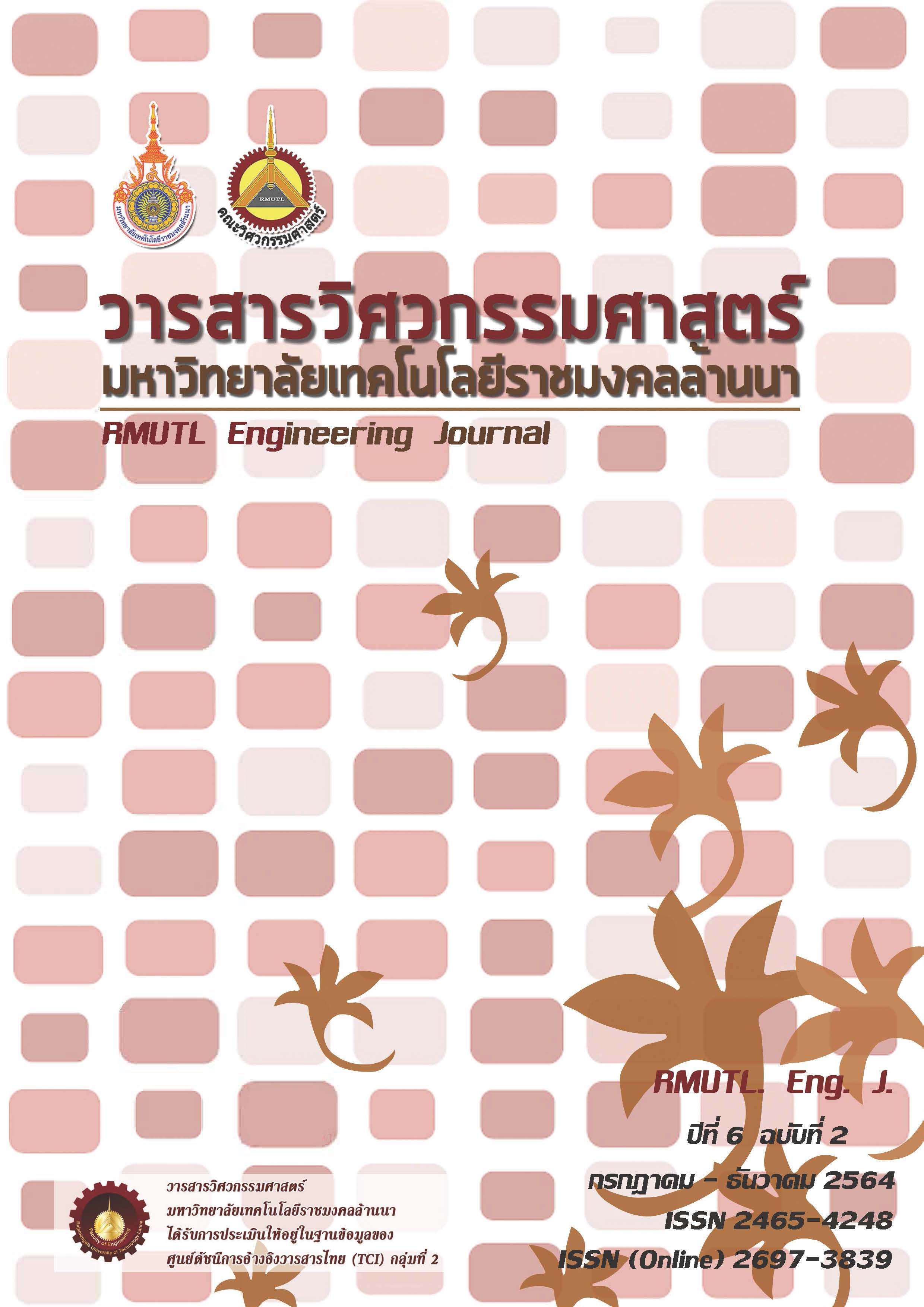Investigation of Properties of Powder Coating Sludge-Indian kaolin Based Geopolymer
DOI:
https://doi.org/10.14456/rmutlengj.2021.7Keywords:
Powder Coating Sludge, XRF, Geo-polymer, Indian Kaolin, Compressive StrengthAbstract
The aim of this article is to experimentally investigate the forming and properties of the geo-polymer material by using powder coating sludge and Indian kaolin. The powder coating sludge is a waste from powder coating production process and it was XRF tested to find ingredients of element. The mixture ratios of Indian kaolin and powder coating sludge were 66.7:33.3, 60:40, and 55:45, respectively. The concentrations of sodium hydroxide solution were 5, 10, and 15 mol/L, respectively and concentrations of sodium hydroxide to concentration of sodium silicate solution were 1:1.64, 1:2.46, and 1:3.28, respectively. Specimens were formed according to each mixture and concentration. Then, some properties such as compressive strength, coefficient of thermal conductivity, and water absorbing were standardized tested. It was found that the mixture ratios of Indian kaolin and powder coating sludge of 66.70:33.30, concentration of sodium hydroxide solution of 10 mol/L and concentration of sodium hydroxide to concentration of sodium silicate solution of 1:2.46 was the highest compressive strength as 4.07 MPa. Because the proportion of Indian kaolin was directly varied the ingredient of silica and alumina therefore the high proportion of Indian kaolin caused the high compressive strength. Moreover, the coefficient of thermal conductivity of the highest compressive strength was 0.0892 W/ (m•k). In addition, the lowest of water absorbing was 24.20 %. Finally, the results illustrated that powder coating sludge can replace other engineering materials especially construction and insulation materials because of its high compressive strength and low coefficient of thermal conductivity.
References
[2] Elumalai A, Ganesh GM, Gurumurthy K. An experimental study on performance of bacillus pumilus KC845305 and bacillus flexus KC845306 in bacterial concrete. Journal of Applied Science and Engineering. 2020; 23(1):1-8.
[3] Escalante-Garcia JI, Espinoza-Perez LJ, Gorokhovsky A, Gomez-Zamorano LY. Coarse blast furnace slag as a cementitious material, comparative study as a partial replacement of Portland cement and as an alkali activated cement. Construction and Building Materials. 2009 Jul 1;23(7):2511-7.
[4] Mehta PK. Greening of the concrete industry for sustainable development. Concrete international. 2002 Jul 1; 24(7):23-8.
[5] Temuujin JV, Van Riessen A, Williams R. Influence of calcium compounds on the mechanical properties of fly ash geopolymer pastes. Journal of hazardous materials. 2009 Aug 15;167(1-3): 82-8.
[6] Komnitsas K, Zaharaki D. Geopolymerisation: A review and prospects for the minerals industry. Minerals engineering. 2007 Nov 1;20(14):1261-77.
[7] Duxson P, Fernandez-Jimenez A, Provis JL, Lukey GC, Palomo A, Van Deventer JSJ. Geopolymer: the curret state of the art. Journal of materials Science. 2007 May;42(9):2917-33.
[8] Granizo ML, Blanco-Varela MT, Martinez-Ramirez S. Alkali activation of metakaolins: parameters affecting mechanical, structural and microstructural properties. Journal of Materials Science. 2007 May;42(9):2934-43.
[9] Lin KL, Shiu HS, Shie JL, Cheng TW, Hwang CL. Effect of composition on characteristics of thin film transistor liquid crystal display (TFT-LCD) waste glass-metakaolin-based geopolymers. Construction and Building Materials. 2012; 36: 501-7.
[10] Naskar S, Chakraborty AK. Effect of nano materials in geopolymer concrete. Available from:http://dx.doi.org/10.1016/j.pisc.2016.04.049.
[11] Yunus A. Cengel, Ghajar AJ. Heat and mass transfer : Fundamentals [and] applications. New York: McGraw-Hill; 2011. Appendix.










